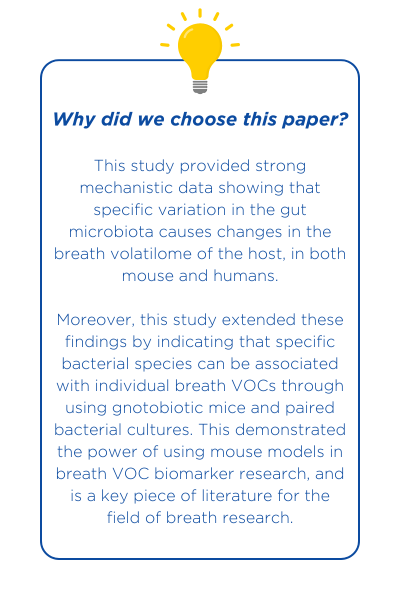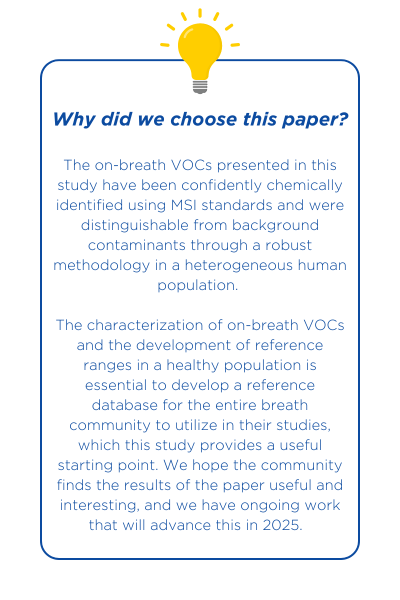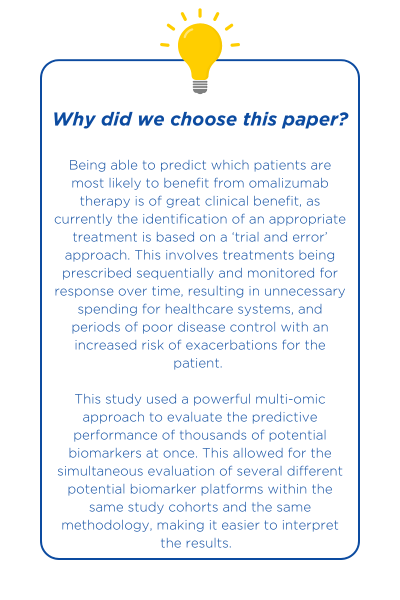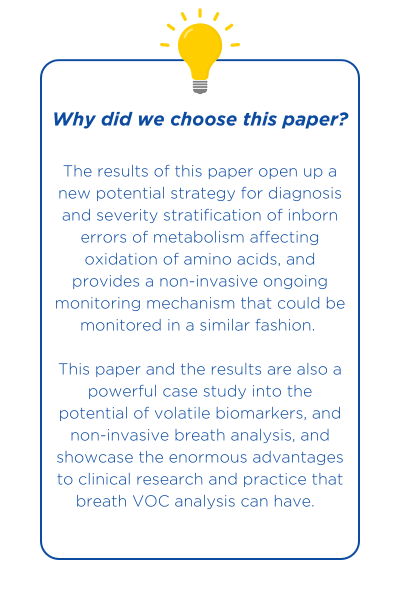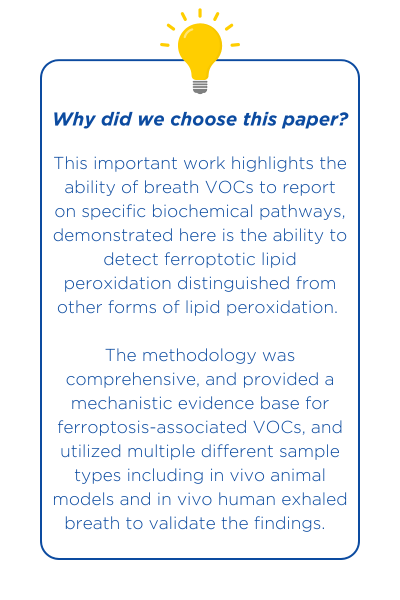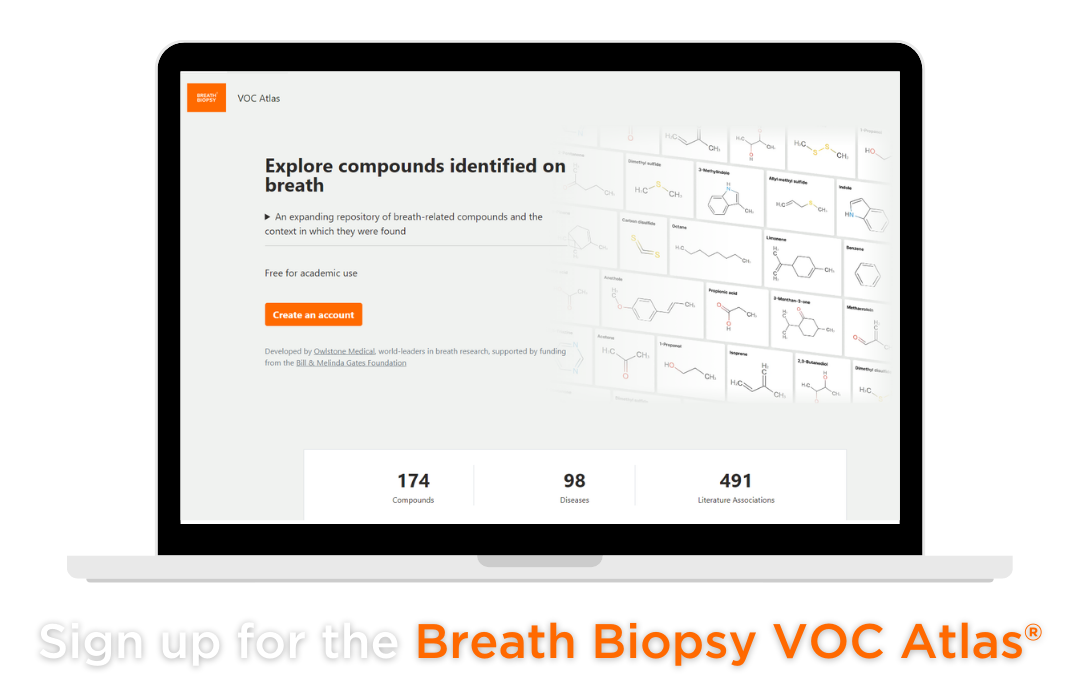Top Picks: Best Breath Research Papers of 2024
Published on: 12 Jan 2025
Each year we compile a few of our favorite breath research papers that have been published , and in 2024 there have been many that have showcased interesting, and important advances in the field. Last year was an especially exciting year within breath analysis, and we have summarized a few of the pieces of research we believe helped to shape the future of the field, including one of our own!
The gut volatilome is shaped by the gut microbiota (Hernandez-Leyva et al.)
The gut microbiome is known to play an important role in health and disease, and is thought to be responsible for a significant number of volatile organic compounds (VOCs) that are detectable in exhaled breath. To facilitate the use of VOC breath biomarkers of microbial activity, identifying to what degree VOC changes in the breath reflect changes in the gut microbiota is important. This study advanced this significantly, by comparing the breath VOC profile of 27 healthy children to the microbiota species detectable in paired stool samples. Then, they used a gnotobiotic mouse model to match the VOCs emitted from cultured gut microbes to the VOCs detectable in the breath of mice colonized with the same bacterial strains.
Among the associations seen, E. coli was correlated in the breath of mice with benzothiazole, ethyl acetate, and octanal, B. thetaiotaomicron was associated with acetone, and C. aerofaciens was associated with toluene. Pentane was reduced in both the bacterial culture headspace, and in the breath of mice colonized with R. torques. Together, these results suggest that not only do distinct microbial communities in the gut influence the VOC composition of breath, but that individual VOCs can be associated with specific bacterial species.
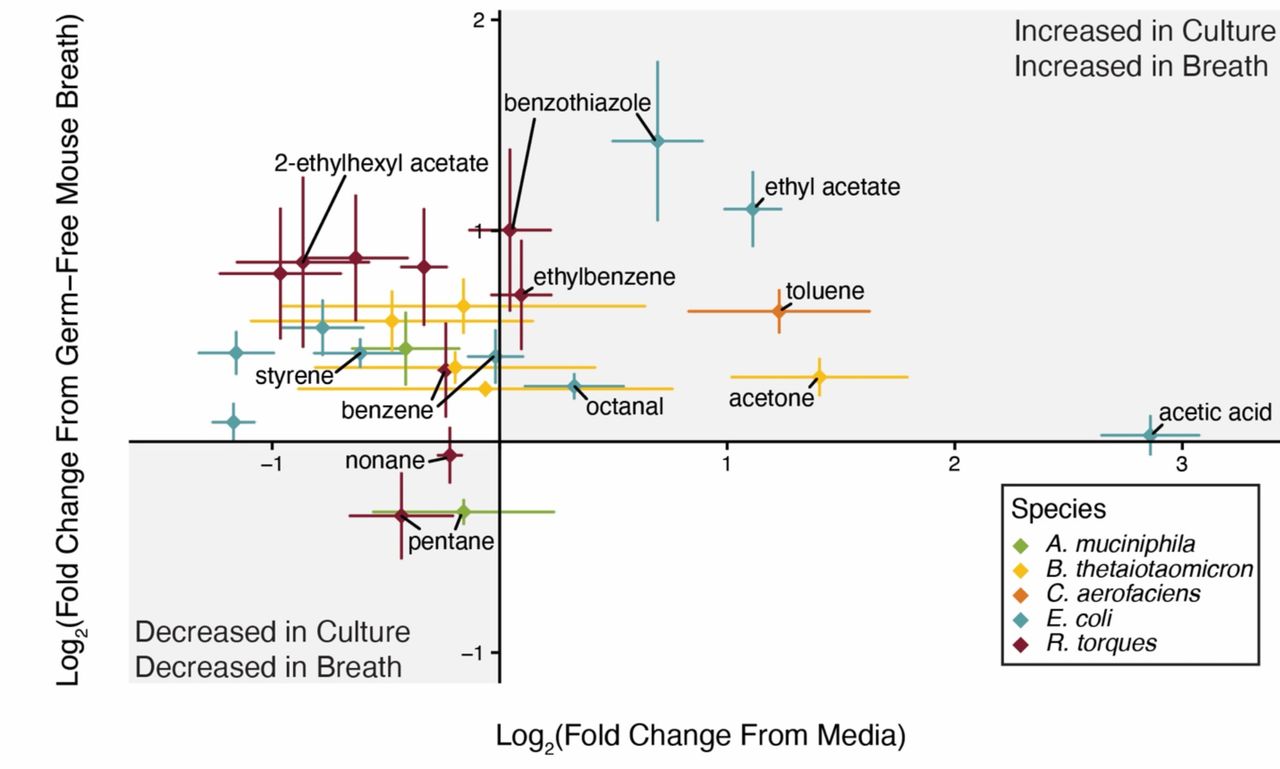
Figure 1: ‘Comparing the volatilome of anaerobic culture headspace to the exhaled breath of monocolonized mice identifies potential gut microbiota-derived breath VOCs’ adapted from Hernandez-Leyva et al.
High-quality identification of volatile organic compounds (VOCs) originating from breath (Arulvasan et al.)
One of the key goals of breath research currently is to improve standardization across the field. There is a general lack of standardization in sampling, analysis, and identification of VOCs in the literature, meaning that it is difficult to quickly assign confidence to any single observation. This results in a limited ability to validate clinically useful breath biomarkers. There is an urgent need to develop a robust platform that can accurately identify the VOCs considered to be genuinely originating from the breath (which are comprised of endogenous VOCs derived from metabolic processes and exogenous VOCs, such as microbiome or dietary compounds). It is important to distinguish these VOCs from background VOCs which are unrelated to underlying physiology.
Therefore, our team undertook an ambitious study to develop a novel methodology that combines robust breath and background collection, analytical distinguishing of breath VOCs from background contamination, and VOC identification against chemical standards. The results were published in 2024 in Metabolomics, and outline a list of 148 on-breath VOCs that have been reliably distinguished from the background, and chemically identified using purified chemical standards in a nominally healthy population.
Biomarkers of Clinical efficacy of the anti-IgE biologic omalizumab in severe asthma in adults: results of the somosa study (Djukanović et al.)
This study utilized an innovative multi-omic approach in those with severe asthma to assess the potential links between responsiveness to omalizumab – an anti-IgE monoclonal antibody that can significantly reduce asthma exacerbations – and the composition of exhaled breath, blood, induced sputum, and urine. A total of 1408 variables were captured across the sampling mediums utilized, including 70 breath VOCs, and 158 eNose signatures without molecular identities. VOC breath analysis generated two panels of 5 VOCs, one for predicting early improvement and one for predicting > 50% exacerbation reduction.
Although plasma lipids had greater predictive ability than breath VOC biomarkers, breath VOC analysis was considered a superior biomarker discovery and analytical platform due to the ease of breath collection, and an easier development pathway of point-of-care devices for use in a clinical setting. Interestingly, GC-MS-based approaches to breath analysis were seen to outperform eNOSE-based approaches, which could not predict clinical improvement. This suggests that the ability to assign VOC identities is informative for clinical use, and can pull out a greater depth of detail for superior biomarker development.
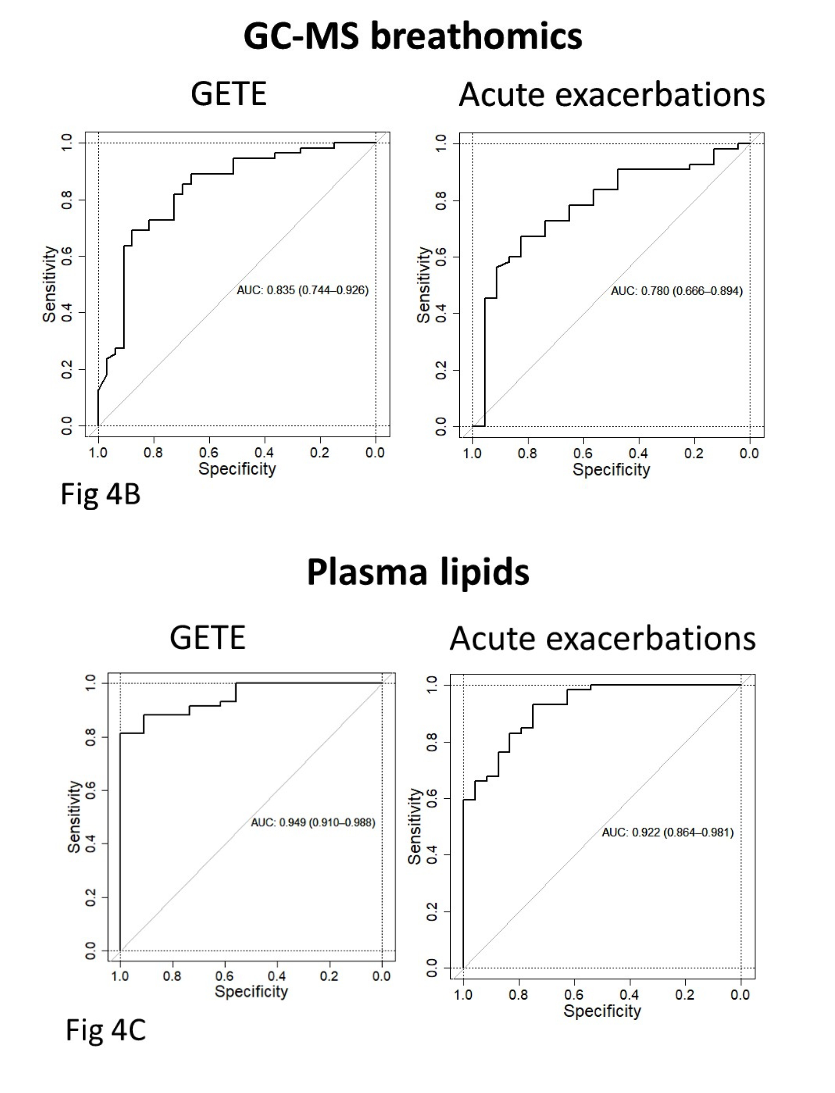
Figure 2: ‘Receiver operating characteristic area under the curve (ROCAUC) diagrams for GC-MS breath VOC analysis (breathomics) (4B), and plasmic lipidomics (4C) are shown’ adapted from Djukanović et al.
Breath Biopsy in Inborn Errors of Metabolism: A Proof-of-Principle Study in Propionic Acidemia (Shchelochkov et al.)
Propionic acidemia (PA) is a rare metabolic disorder where the body is unable to process certain lipids and proteins, which can result in serious effects. PA is characterized by the deficient activity of propionyl-CoA carboxylase, an enzyme that processes the branched-chain amino acids (BCAAs) isoleucine and valine, as well as other sources of odd-chain carbon. PA is thought to result in the accumulation of certain volatile compounds, providing a potential avenue for non-invasive biomarker analysis.
This study assessed the hypothesis that enzymatic defects in the BCAA oxidation pathway can change the composition of VOCs in the body, with accumulation of specific VOCs in exhaled breath expected to be proportionate to the severity of disease. Unbiased screening identified several candidate VOC biomarkers of PA, including 3-pentanone which was the most abundant (45-fold higher in cases vs. controls, p-value < 0.05), and abundance positively correlated with other clinical biomarkers of PA. Interestingly, 3-pentanone levels were lower and segregated with “mild” PA in a participant who received an orthotopic liver transplant.
Volatile oxidized lipids generated via metal-dependent lipid peroxidation of ω-6 PUFAs are breath biomarkers for monitoring ferroptosis in vivo (Matsuoka et al.)
Ferroptosis has recently been recognized as a unique form of cell death that is distinct from apoptosis. Ferroptosis is defined by its reliance on iron to drive lipid peroxidation within cell membranes, and is thought to play a role in a wide range of disease, including cancer, ischemia-reperfusion injury, kidney disease, neurodegenerative disorders, and more. Ferroptosis seems to exacerbate disease progression, however, interestingly, ferroptosis can also play a beneficial role in targeting cancer cells, making it a potential therapeutic target in certain malignancies.
This study investigated the oxidized lipid fragment VOCs released by ferroptosis, with the methodology including in vitro work, cell culture work, in vivo and in homine work. A VOC library was generated from the products of lipid peroxidation of various poly-unsaturated fatty acids (PUFAs), defined as VOCs that demonstrate a two-fold increase under conditions of lipid peroxidation over controls. A total of 48 VOCs were detected arising from the oxidation of 4 ω-6 and ω-3 PUFAs, with products from ferroptosis resulting in a wider diversity of measured VOCs. Several identified volatile oxidized lipids (VOLs) including 1-octen-3-ol and 2-pentylfuran were validated as ferroptotic, common to in vitro cultured cells, in vivo animal models, and human exhaled breath.
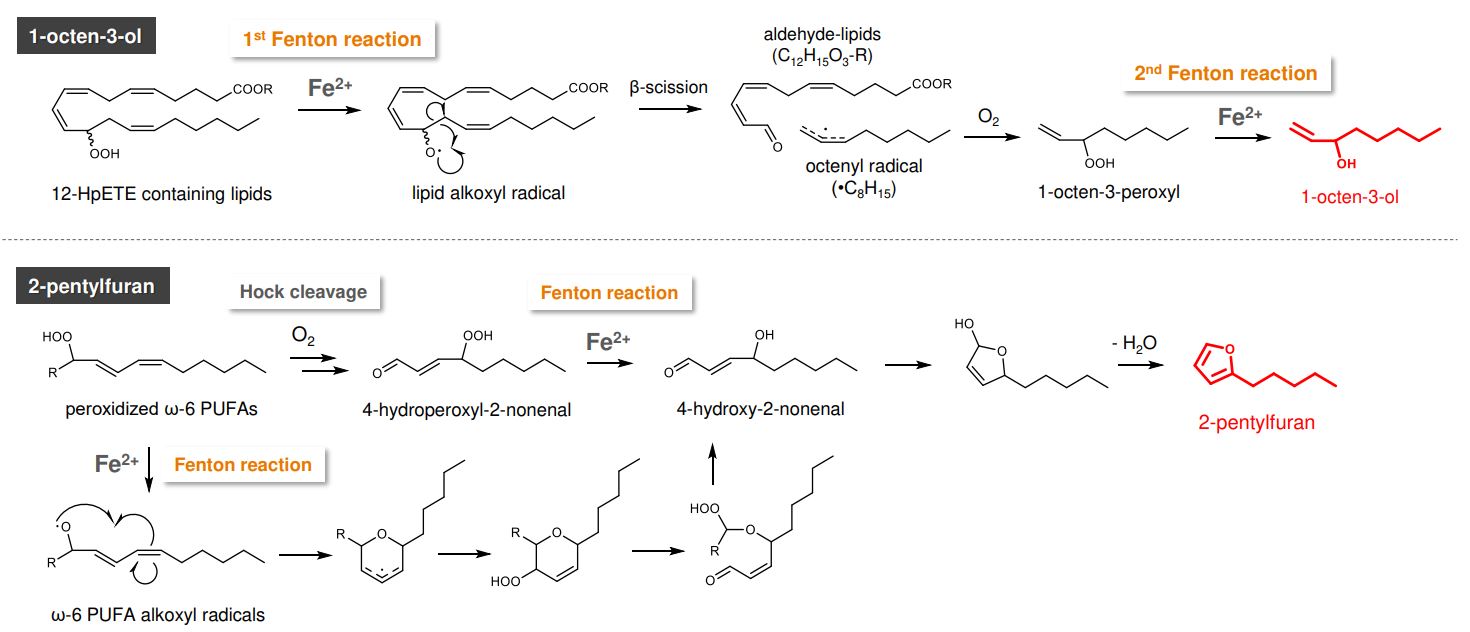
Figure 3: ‘Proposed generation mechanisms of 1-octen-3-ol and 2-pentylfuran, with the requirements for iron-catalysed reaction steps highlighted’ adapted from Matsuoka et al.
If you have enjoyed this blog, take a look at our favorite papers from 2023!
